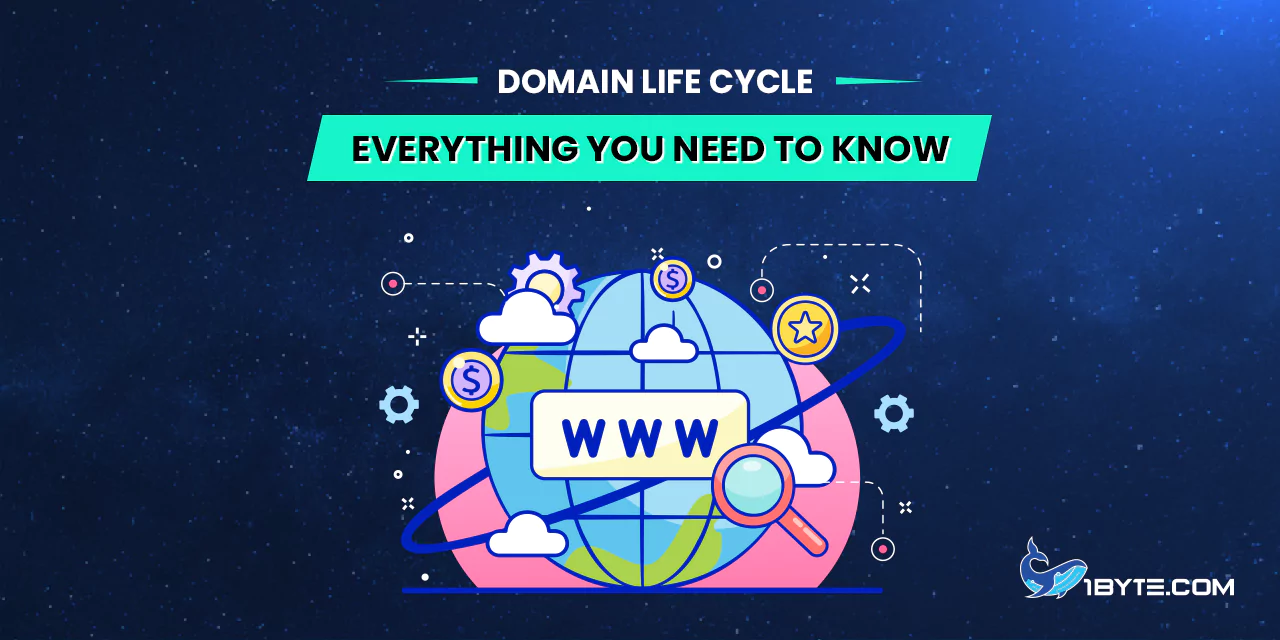Major organizations have learned the hard way about domain expirations. For example, the Dallas Cowboys once forgot to renew their domain name, causing their website to go down for days during a critical time. This incident highlights how crucial it is to understand the domain life cycle. Every website’s address (domain name) passes through a series of stages from registration to expiration. Knowing these stages helps domain owners avoid losing their online identity and enables interested buyers to seize opportunities. In fact, the domain market is huge – by the end of 2024 there were about 364.3 million domain name registrations across all top-level domains worldwide. Yet thousands of domains expire every single day. Understanding what happens when a domain expires is essential knowledge for anyone with an online presence. Read this article from 1Byte to find out more.
What Is the Domain Life Cycle?
The domain life cycle is the sequence of stages a domain name goes through from initial registration until its deletion. When you register a new domain, you don’t own it permanently. You get the right to use the domain for a set period of time. This period is typically between 1 to 10 years, depending on what term you paid for. If you want to keep using the domain name (for your website, email, etc.), you need to renew the registration before it expires. If you fail to renew, the domain enters its expiration phase. Eventually it returns to the pool of available domains for others to register.

Importantly, a domain does not vanish the instant it hits its expiration date. There are built-in grace periods and processes after expiration that give the current owner a final chance to recover the domain. If the owner doesn’t act, others get a chance to grab it. In other words, every domain name goes through several status cycles before it’s finally released to the public again. Below is an overview of the key stages in a typical domain life cycle for generic top-level domains (gTLDs like .com):
Stages of a Domain Name’s Life Cycle
The typical life cycle of a gTLD domain name, from initial registration through expiration, redemption, and deletion. Each stage offers opportunities for renewal or recovery before the name is finally dropped and made available again.
- Available (Unregistered) – This is the starting point. The domain name is free for anyone to register on a first-come, first-served basis. If no one has registered example.com yet, it is considered available. Once someone registers it, the domain moves to the next stage.
- Active Registration Period – After registration, the domain is active and belongs to the registrant (owner) for the term they paid for. By default, this period is usually 1 year, but owners can register for multiple years at once. During this active period, the owner has full control of the domain. They can use it for a website, set up email, or simply hold it as an investment. It’s worth noting that domain registration is big business. Over 33,000 new domains are registered daily around the world. This means securing a good name and keeping it renewed is very important.
- Expiration & Grace Period – This stage begins when the active registration period ends without a renewal. The domain then enters an expired grace period. At this point, the domain is often put on hold by the registrar. The website and email might stop working during this hold. However, the original owner can still renew the domain for a short window without any major penalty. Many famous cases of lapsed domains get caught in this phase and are renewed late. As the saying goes, better late than never. If the owner ignores expiration notices and fails to act during the grace period, things move to the next stage.
- Redemption Period – This stage kicks in if the initial grace period passes without renewal. The domain goes into a Redemption Grace Period at the registry. This redemption phase is typically about 30 days long for .com and most gTLDs. At this stage, the domain is removed from the zone files (so any website or email stops working completely). The owner’s control is also suspended. Redemption usually comes with an extra fee (often significantly higher than a normal renewal) as a penalty. However, it’s essentially the last-chance opportunity to get the domain back before it’s gone for good. If the owner redeems the domain in time (within those 30 days), it is restored to active status after the fees are paid. If not, the domain heads to the next and final phase.
- Pending Deletion – After the redemption period lapses without a restoration, the domain enters Pending Delete status. This period lasts about 5 days. In this phase, no one (not even the previous owner) can renew or redeem the domain. The domain is essentially locked and scheduled for removal from the registry.
- Deletion (Domain Dropped) – Once the pending delete phase is over (usually on the fifth day), the domain name is deleted from the registry. The domain is now completely free and returns to general availability. The moment of deletion is critical. Coveted names can be snapped up within seconds by people or companies who have been waiting for them to drop. Essentially, once a name is dropped, it is like a brand new domain again. Whoever registers it next becomes the new owner. The life cycle then starts over from stage 1 under that new owner.
Throughout these stages, different outcomes are possible. Many domains are renewed without issue, and the cycle simply continues with extended active periods. But a significant portion are not renewed – roughly one in four .com domain registrations are left to expire by their owners, judging by recent renewal statistics. For example, the renewal rate for .com and .net domains in late 2024 was about 73.9% (meaning ~26% were not renewed). With millions of domains expiring each year, this leads to a busy market for expired domains.
It’s also worth noting that if an expired domain is deemed valuable (high traffic, premium name, etc.), the registrar might not simply let it delete without trying to profit. Often, registrars will auction off desirable expired domains before the final deletion. They may have agreements to sell expiring domains via aftermarket platforms. If multiple parties are interested in an expiring domain, the name might go to a bidding war. In that case, the highest bidder wins the domain. These auction systems can occur during or right after the grace period. If a sale is made, the winner becomes the new registrant without the domain ever reaching the open market. If no one buys the domain at auction, and the owner still doesn’t renew, then the domain proceeds to deletion as described.
1Byte – Your Partner in Domain Management and Hosting

At 1Byte, we understand every aspect of the domain life cycle. We have helped countless individuals and businesses navigate it with confidence. We are proud to be a leading cloud and hosting provider that serves clients worldwide. With international, state-of-the-art data centers, we offer reliability and performance that global providers simply can’t match. Our team’s experience and dedication have quickly earned us a strong reputation.
1Byte’s domain services are an integral part of our one-stop solutions. We offer an extensive selection of domain name extensions (TLDs) so that customers can find the perfect web address for their brand. From popular .com and .net domains to country-specific TLDs, we provide a wide range of choices. We help clients select an ideal name for their online identity. Our platform makes domain registration and management straightforward, and our support team is always ready to assist. We use our expertise to ensure that no client accidentally loses a domain. With features like auto-renewal, timely reminders, and guidance on best practices, we help safeguard your online assets. If a customer wants to acquire a domain that’s already taken, we can assist with the domain backorder process. We leverage our industry contacts and tools to give them the best chance of success.
What sets 1Byte apart is not just our services, but our philosophy. We combine global-standard technology with deep insight. Our clients benefit from lower latency, personalized support, and solutions tailored to their unique requirements. Whether it’s web hosting, cloud servers, or domain management, we approach each with a customer-centric mindset. We have helped startups and established companies the world over build their online presence from the ground up. Our vision is to empower businesses of all sizes with easy and affordable access to digital infrastructure. From registering your very first domain to scaling up on cloud servers, we are with you at every step. 1Byte’s experience in domain services, combined with our robust cloud and hosting solutions, ensures that your domains are in safe hands when you work with us. We take pride in being a trusted partner in our clients’ digital journeys. We look forward to helping many more organizations navigate the domain life cycle successfully.
Leverage 1Byte’s strong cloud computing expertise to boost your business in a big way
1Byte provides complete domain registration services that include dedicated support staff, educated customer care, reasonable costs, as well as a domain price search tool.
Elevate your online security with 1Byte's SSL Service. Unparalleled protection, seamless integration, and peace of mind for your digital journey.
No matter the cloud server package you pick, you can rely on 1Byte for dependability, privacy, security, and a stress-free experience that is essential for successful businesses.
Choosing us as your shared hosting provider allows you to get excellent value for your money while enjoying the same level of quality and functionality as more expensive options.
Through highly flexible programs, 1Byte's cutting-edge cloud hosting gives great solutions to small and medium-sized businesses faster, more securely, and at reduced costs.
Stay ahead of the competition with 1Byte's innovative WordPress hosting services. Our feature-rich plans and unmatched reliability ensure your website stands out and delivers an unforgettable user experience.
As an official AWS Partner, one of our primary responsibilities is to assist businesses in modernizing their operations and make the most of their journeys to the cloud with AWS.
Conclusion
The domain life cycle is something every domain owner and prospective buyer should be familiar with. It’s far more than just “register it and forget it.” There are critical deadlines and opportunities at each stage. Missing a renewal can mean losing a valuable domain that you’ve built your brand on – as several famous companies have learned the hard way. On the flip side, understanding the cycle opens up chances to acquire great names through different strategies. By keeping track of expiration dates and using options like auto-renew, you can avoid most problems. Partnering with a reliable provider (like 1Byte) for support also helps you master the domain life cycle. A little knowledge and proactive action will ensure your online identity remains secure, and that you can capitalize on opportunities when they arise. The world of domains is ever-growing and dynamic, but with the right information and partners, anyone can navigate it with ease.

